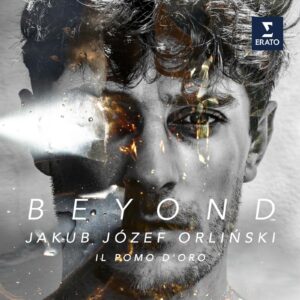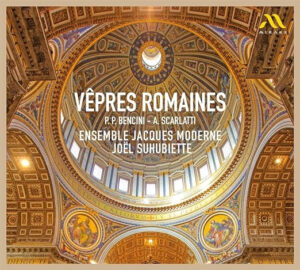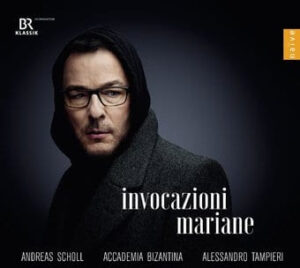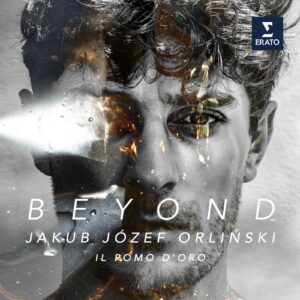Program: #24-14 Air Date: Apr 01, 2024
To listen to this show, you must first LOG IN. If you have already logged in, but you are still seeing this message, please SUBSCRIBE or UPGRADE your subscriber level today.
The early Italian 17th century with Jakob Jozef Orlinski, a Roman Vespers by Pietro Paolo Bencini, and the new release by Andreas Scholl with the Accademia Bizantina.
I. Beyond (Jakob Józef Orliński/Il Pomo d’Oro). Erato 5054197726453.

The idea of developing a programme for Jakub’s voice based around the Seicento (the 17th century in music) had been gestating in my mind for quite some time, given the particular expressiveness of his musicality in this repertoire. So vast are the possibilities afforded by this era that compiling the album, making the right choices, felt a daunting task: from operas to cantatas, serenades to canzoni for solo voice, the prospects seemed endless. I chose then not to choose, taking instead just one example from each of these forms, thus offering the listener an aural glimpse of the riches of this century.
Each programme I’ve constructed for Jakub has featured a core composer, a guiding light whose music inspires me through the development of the recital or brings that missing atmosphere to its overall balance. For Anima Sacra, this was Nicola Fago (1677–1745); for Facce d’Amore, we had Giovanni Antonio Boretti (1640–1672) and Luca Antonio Predieri (1688–1767), with two arias apiece to open and close the programme; for Anima Aeterna, the honour went to Jan Dismas Zelenka (1679–1745). Here, for Beyond, our most represented figure is Giovanni Cesare Netti (1649–1686). It was only by chance that I discovered his manuscripts in the course of my research, and I was struck by the beauty of his compositions. The variety that inhabits his scenes is unbelievable; a single scene may feature a character producing recitatives and arias of totally different textures and colours. This is certainly the case here in Berillo’s scene from Netti’s opera La Filli (La moglie del fratello) (1682).
As fate would have it, we were contacted by Professor Giovanni Tribuzio – eminent musicologist and no less than the author of Netti’s catalogue of works – when he found out the composer was due to be featured. It was inevitable, therefore, that he should be included in this booklet to shed more light on this magnificent artist, one I hope to see more frequently performed in future[see page 17].
Although we will mostly be journeying through the Italian Seicento, a few pieces along the way hail from different origins, among them Adam Jarzębski (c.1590–1649) and Johann Caspar von Kerll (1627–1693). In among some rare gems (a dozen or so world premieres), any listener familiar with the era may recognise a few titles that could be considered “hits” of the repertoire of this first baroque century (Monteverdi, Caccini, Frescobaldi). Furthermore, the order of the programme deviates slightly from its predecessors: with this album, Jakub and I sought to go beyond a simple presentation of beautiful pieces, offering the listener the sense of being at a real-life concert. This is reflected in direct sequences between certain pieces, improvised instrumental transitions, a logical succession of atmospheres, of keys and of musical themes, all rising to a palpable head in perfect synergy with the emotions that Jakub and Il Pomo d’Oro have chosen to share with us.
CLAUDIO MONTEVERDI c.1567–1643
- E pur io torno qui (Ottone, Atto I, scena 1) 8.51
L’incoronazione di Poppea SV 308 (Giovanni Francesco Busenello, Venezia, 1642) - Canzone a voce sola: Voglio di vita uscir SV 337 4.57
JOHANNES HIERONYMUS KAPSBERGER 1580–1651
- Kapsberger Libro quarto d’intavolatura di Chitarone (Roma, 1640) 3.21
GIULIO CACCINI 1551–1618
- Madrigale a voce sola: Amarilli, mia bella (?[G.B. / Alessandro] Guarini) 3.25
Le nuove musiche (Firenze, 1602)
GIROLAMO FRESCOBALDI 1583–1643
- Aria di passagaglia: Così mi disprezzate? F.7.16 2.29
Primo libro d’arie musicali per cantarsi (Firenze, 1630)
BARBARA STROZZI 1619–1677
- L’amante consolato Cantate, ariette e duetti Op.2 (Venezia, 1651) 2.53
FRANCESCO CAVALLI 1602–1676
- Incomprensibil nume (Pompeo Magno, Atto II, scena 1)
Pompeo Magno (Nicolò Minato, Venezia, 1666)* 3.06
JOHANN CASPAR VON KERLL 1627–1693
- sonata for 2 violins & continuo in f 6.13
CLAUDIO SARACINI 1586–1630
- Udite, lagrimosi spirti d’Averno
Le seconde musiche (Venezia, 1620) 2.41
CARLO PALLAVICINO c.1630–1688
sinfonia Demetrio (Venezia, 1666)
- I. Grave 0.58
- II. Affettuoso 1.08
- III. Presto 0.35
- IV. Adagio 0.59
PIETRO PAOLO CAPPELLINI fl. 1641–1660
- Tarantella: Chi vuol ch’il cor gioisca 2.36
Raccolta di Ariette (Venezia, 1670/80)
GIOVANNI CESARE NETTI 1649–1686
(Berillo, Atto II, scena 9)
- Aria: Misero core 2.23
- Recitativo & aria: Datti pace, Berillo…Sì, sì, si sciolga, sì… 1.15
- Recitativo: Ah, che miei voi non siete… 0.24
- Aria: Dolcissime catene 2.45
La Filli (La moglie del fratello) (?Francesco Silvani, Napoli, 1682)*
ANTONIO SARTORIO 1630–1680
- La certezza di sua fede (Pompeiano, Atto III, scena 5)* 3.22
Antonino e Pompeiano (Giacomo Francesco Bussani, Venezia, 1677)
GIOVANNI CESARE NETTI
- Quanto più la donna invecchia (Crinalba, Atto I, scena 11)* 1.33
L’Adamiro (Baldassarre Pisani, Palermo, 1682)
BIAGIO MARINI
- la vecchia innamorata (arranged for instrumental ensemble)
Scherzi & canzonette Op.5 (Parma, 1622) 2.12
GIOVANNI CESARE NETTI
- Son vecchia, pazienza (Crinalba, Atto II, scena 13)* L’Adamiro 3.36
GIUSEPPE ANTONIO BERNABEI 1649–1732
- A battaglia, su, mio core (Eugerio, Atto III, scena 6) 2.06
Il segreto d’amore in petto del Savio (Luigi Orlandi, Munich, 1690)*
ADAM JARZĘBSKI c.1590–1649
- Concerto a 3 voci & continuo: tamburetta (c.1627) 2.28
GIOVANNI BATTISTA VITALI 1632–1692
Cantata for contralto with strings & continuo:
Donde avvien che tutt’ebro di vera gioia (c.1685)*
- sinfonia 1.22
- Recitativo: Donde avvien che tutt’ebro di vera gioia 0.39
- Aria: Nell’anglica sede, vessillo di fede 2.06
- Recitativo: Maria germe real del tronco estense 0.30
- Aria: Frema l’Erebo adirato 1.32
- Recitativo: Ma di fatti, si degni 0.22
- Aria: Se nunzia fedel con tromba sonante 1.36
CARLO FRANCESCO POLLAROLO 1653–1723
(Mercurio, Atto III, scena 15)
- Come allor, che più densi… 0.33
- Son tanto avvezzo a piangere 2.53
La costanza gelosa negl’amori di Cefalo e Procri (Verona, 1688)
SEBASTIANO MORATELLI 1640–1706
- Lungi dai nostri cor (Amore) La faretra smarrita (c.1690) 4.19
82.18
Jakub Józef Orliński countertenor
Il Pomo d’Oro
* world-premiere recording
II. Vêpres Romaines (Ensemble Jacques Moderne/Joël Suhubiette). Mirare MIR602.

From the mid-seventeenth century to the first two decades of the eighteenth century, Rome experienced one of the most brilliant musical periods in its history.
In this recording, the Ensemble Jacques Moderne works composed for a Vespers service, one of the principal moments of the Liturgy of the Hours, which consisted of a sequence of psalms and antiphons concluding with a Magnificat.
- Bencini: Deus in Adjutorium Pour Chur Et Basse Continue
- Bencini: Ave Maris Stella, Hymne Pour Soprano, Chur Et Basse Continue
- Bencini: Laeva Eius, Antienne Pour Soprano Solo
- Bencini: Dixit Dominus (Psaume 109) Pour Double Chur Et Basse Continue
- Bencini: Dum Esset Rex, Antienne Pour Soprano Solo
- Bencini: Beatus Vir (Psaume 111) Pour Soprano Et Contre-Ténor Solo, Chur Et Basse Continue
- Bencini: Nigra Sum, Antienne Pour Contre-Ténor Solo
- Scarlatti: Laudate Pueri Dominum (Psaume 112) Pour 5 Soli, Chur Et Basse Continue
- Scarlatti: Magnificat Pour 5 Soli, Chur Et Basse Continue
III. Invocazioni Mariane (Andrea Scholl/Accademia Bizantina/Alessandro Tampieri). Naive V 5474.

For the first time with naïve, the countertenor Andreas Scholl joins the Accademia Bizantina and Alessandro Tampieri to present a Neapolitan programme, centred on the Virgin Mary.
Andreas Scholl and the Accademia Bizantina have for several decades enjoyed a successful musical partnership, encompassing the whole Baroque repertoire.
As usual, this new album together includes both renowned and less well-known vocal and instrumental pieces.
The figure of Mary, which has inspired a huge repertoire, both sacred and profane, runs through this Easter programme of exquisite affliction, virtuosic for both voice and orchestra.
“Neapolitan music has a unique melodic vein and a great capacity to communicate emotion profoundly,” says Alessandro Tampieri.
Thus, Vivaldi’s iconic Stabat Mater, which the German countertenor has enjoyed singing for many years, is placed alongside lesser-known airs from oratorios by Nicola Porpora and Leonardo Vinci, which had the character of the Virgin sung by a castrato.
“I endeavour to place humanity before gender,” says Andreas Scholl, “and I interpret the role of Mary with the greatest sincerity, without the slightest notion of ‘travesty’. Love, despair and pain transcend the notion of gender.”
We also find a Salve Regina by Pasquale Anfossi, requiring a particularly participative orchestra, a sonata by Angelo Ragazzi and a violin concerto by Pergolesi, both strongly echoing Pergolesi’s famous Stabat Mater.
The solo violin parts are played by Alessandro Tampieri, first violin of the Italian ensemble, who conducts here from his instrument in the purest tradition of the Baroque orchestra.
From Opera Ramblings: Invocazioni Mariane is a new CD from counter-tenor Andreas Scholl and his long time collaborators the Accademia Bizantina and their conductor Alessandro Tampieri. It consists of 18th century music from Naples; all of which is in some way connected with the Virgin Mary and is mostly drawn from oratorios or similar pieces designed to be performed during Holy Week. Back in the day, with women not permitted on the stage in Naples (or the Papal States) the high parts would have been sung by castrati. That, of course, is where Scholl comes in.
It’s all worthwhile music full of the melodic invention characteristic of the Neapolitan School. It’s also quite beautifully performed. I particularly enjoyed Vincvi’s Oratorio Maria Dolorata of 1715, which combines some very beautiful melodies with considerable attack. Also Vivaldi’s majestic Stabat Mater. But really all the vocal music; from Porpora and Anfossi as well as the two previously mentioned is very good. Scholl’s singing is text book. It’s just very beautiful and controlled baroque singing from a true master.
Besides the vocal pieces the album also contains Pergolesi’s Concerto per Violin. Here Tampieri steps up as soloist and plays really well. It’s also an opportunity to hear the Accademis Bizantina without Scholl. They are a really skilled, small band playing period or reproduction instruments. There are eleven strings, archlute, two recorders and keyboards. They also close out the album with a very sweet version of Ragazzi’s Sonata IV in do minore “Imitatio in Salve Regina Mater Misericordiæ”. All in all there’s 82 minutes of music.
- Porpora: Il trionfo della divina Giustizia ne' tormente e morte di Gesù Cristo
- Vinci, Leonardo: Oratorio Maria dolorata
- Anfossi: Salve Regina
- Pergolesi: Concerto per violino in B-Flat Major
- Vivaldi: Stabat Mater, RV621
Composer Info
Claudio Monteverdi (c.1567–1643), Johannes Hieronymus Kapsberger (1580–1651), Giulio Caccini (1551–1618), Girolamo Frescobaldi (1583–1643), Barbara Strozzi (1619–1677), Francesco Cavalli (1602–1676), Johann Caspar Von Kerll (1627–1693), Claudio Saracini (1586–1630), Carlo Pallavicino (c.1630–1688), Pietro Paolo Cappellini (Fl. 1641–1660), Giovanni Cesare Netti (1649–1686), Biagio Marini, Antonio Sartorio (1630–1680), Giovanni Battista Vitali (1632–1692), Carlo Francesco Pollarolo (1653–1723), Sebastiano Moratelli (1640–1706) , P. P. Bencini, A. Scarlatti, Nicola Porpora, Leonardo Vinci, Pasquale Anfossi, Angelo Ragazzi, Pergolesi, Vivaldi
CD Info
Erato 5054197726453, Mirare MIR602, Naive V 5474.
